Johnson R.S. A Modern Introduction to the Mathematical Theory of Water Waves
Подождите немного. Документ загружается.

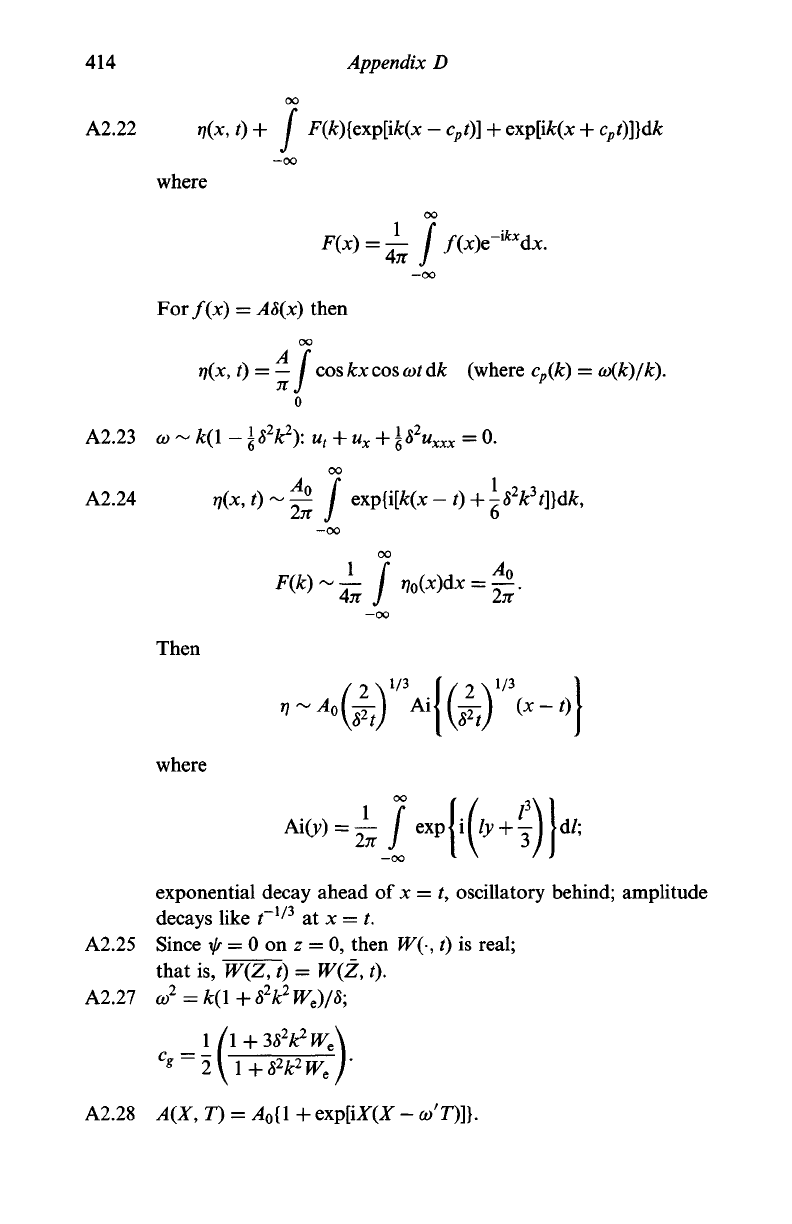
414 Appendix D
oo
A2.22
r,(x,
t)+ f
F(k){exp[ik(x
-
c
p
t)]
+ exp[ifc(jc +
c
p
t)]}dk
—OO
where
oo
F(x) =
± f Ax^dx.
—OO
For f(x) = A8(x) then
oo
A f
rj(x, i) =
—
I cosfoccos&tf
dA:
(where c
p
(k) = co(k)/k).
o
A2.23
a.~fc(l-l
S'k
2
):
u
t
+ u
x
+ \
8
2
u
xxx
= 0.
oo
A2.24 y/O, t)~4± [
exp{i[k(x
-0+7 <
27T
J 6
—oo
oo
Then
where
exponential decay ahead of x = t, oscillatory behind; amplitude
decays like T
1/3
at x = t.
A2.25 Since f = 0 on z = 0, then W(-, f) is real;
that is, W(Z, t) = W{Z, i).
Kill
co
2
=k(l+
S
2
^
2
W
e
)/S;
A2.28 ^(Z, T) =
A
O
{1
+ exp[iZ(Z -
co'T)]}.
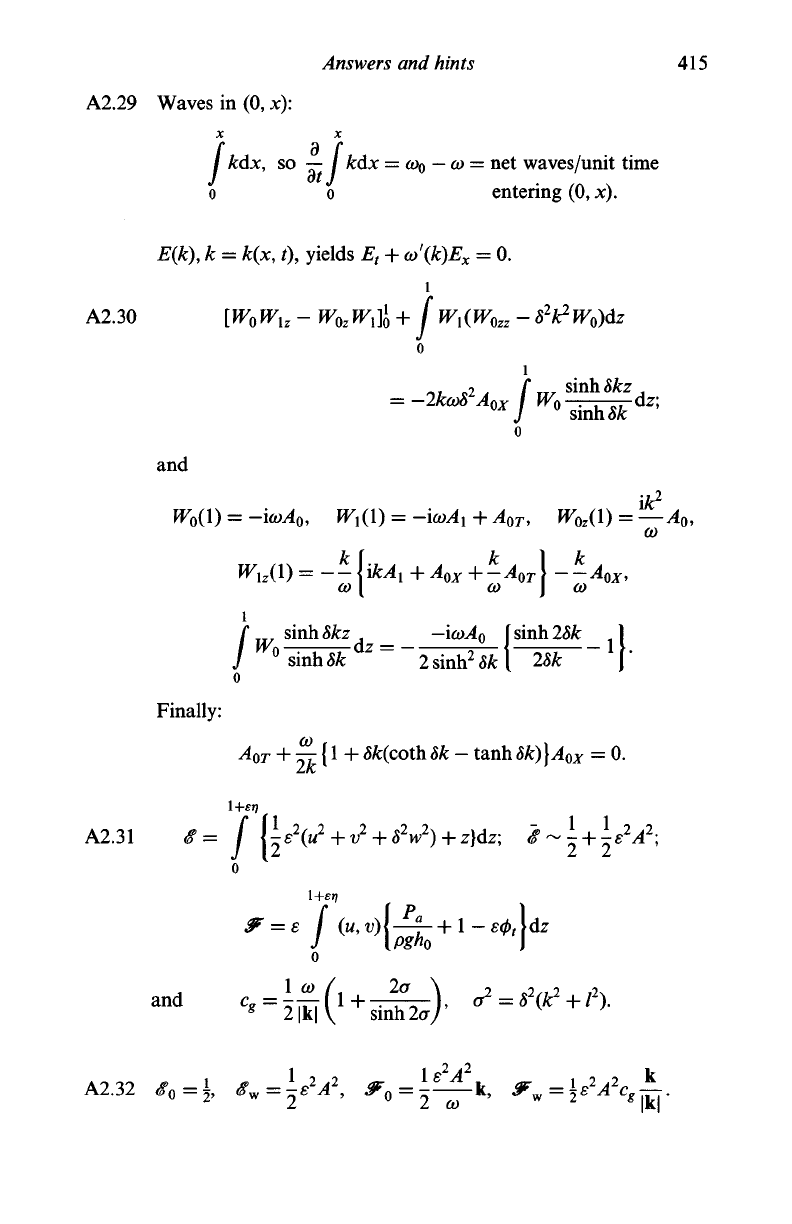
Answers and hints 415
A2.29 Waves in (0, x):
X
X
I kdx, so — / kdx =
o)
0
— (o
= net waves/unit time
o o entering (0, x).
E(k),
k = k(x, t\ yields E
t
+ co\k)E
x
= 0.
I
A2.30
[WoW
Xz
-
W
Oz
W
x
i
+ f
W
{
(W
Ozz
- 8
2
k
2
JV
0
)dz
and
= -icoA
0
, W
x
(\) = -\coA
x
+ A
0T
,
W
Oz
(l)
= —A
o
,
CO
k \ k
/
Wo
tnh8k
dz
=
-
2
~stT
2
°8k
{^r
"
1
1'
o
Finally:
AQT
+ ;rr
{1
+ 8k(coth 8k
—
tanh 8k)\A
0X
= 0.
A2.31
and
1
2 2
l£
2
,4
2
2
2 k
0-2' w~2
£
' °~2
CO
' w-2
£
^|
k
|«
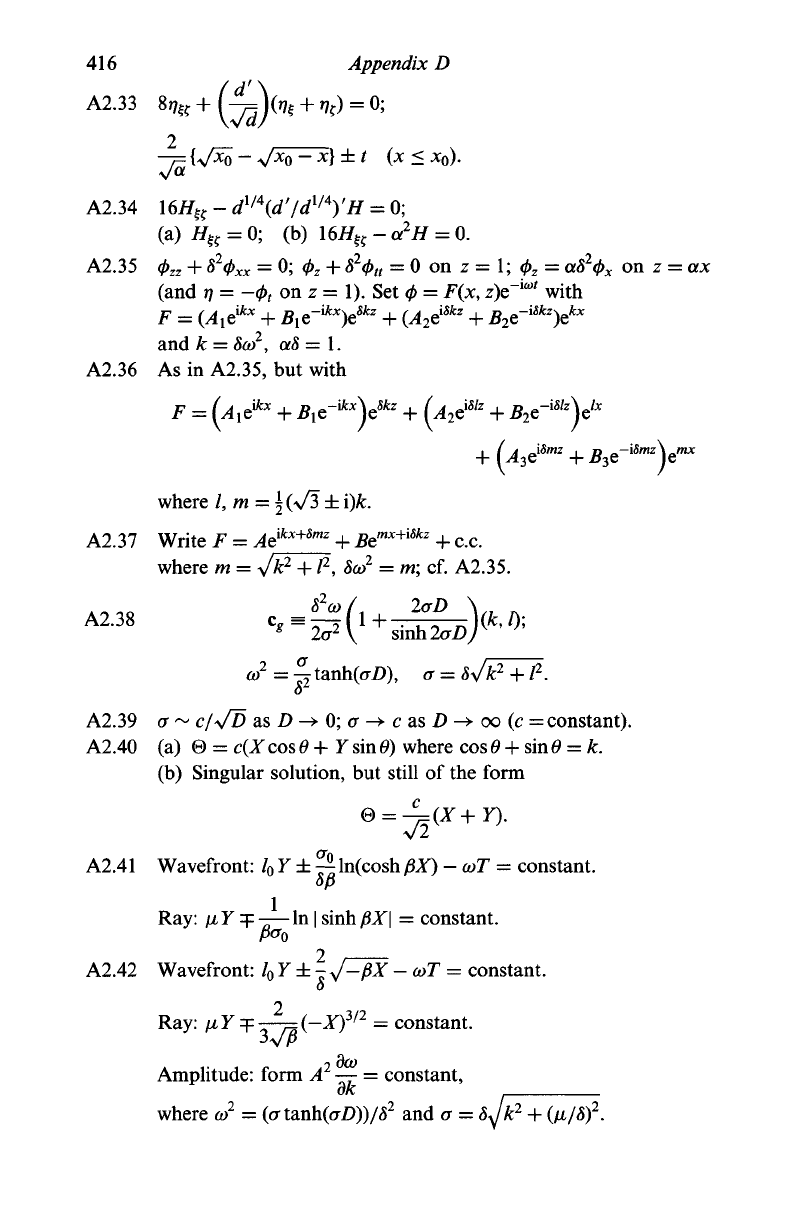
416
Appendix
D
A2.33
8%
p V*o - x) ±t (x< x
0
).
A2.34 l6H
H
-d
l/4
(d'/d
l/4
)'H =
0;
(a)
% =
0;
(b)
16%
- a
2
H = 0.
A2.35
</>
zz
+
S
2
</>^
=
0;
<p
z
+
8
2
<p
tt
= 0 on z = 1;
<£
z
=
aS
2
^
on z = ax
(and
>;
= -0, on z = 1). Set 0 =
F(x,
z)
e
-
ia
"
with
F
= (A^ +
fi,e-
to
)e
fc
+
(A
2
e
iskz
+
B
2
e~
iskz
)e
kx
and
k =
Sa>
2
,
aS
= 1.
A2.36
As in
A2.35,
but
with
F = (A^* + 5,e-
fc
)e
fc
+
(A
2
<i
islz
+ 5
2
e-
i
where
l,m = \
(\/3
± i)k.
A2.37 Write
F =
Ae
{kx+Smz
+
Be
mx+{skz
+
c.c.
where
m = y/k
2
+1
2
,
Sa>
2
= m; cf.
A2.35.
A2.38
Cg
J
8
2
co
=
-^-tanh(<xD),
cr
=
<
A2.39 o-
~
c/yfD
as
Z)
-> 0; a -> c as
Z)
-^ oo (c =
constant).
A2.40
(a) 0 =
c(X cos
0
+ 7
sin
0)
where cos 0
+
sin
0
= fc.
(b) Singular solution,
but
still
of
the form
A2.41 Wavefront: /
0
Y ±
— ln(cosh ^Z)
-
coT
=
constant.
Ray:
/x
Y
q=
—- In
|
sinh
j8Jf|
=
constant.
P^
2
A2.42 Wavefront: /
0
Y ± - J-&X -
ooT
=
constant.
8
2
Ray: /xF^—-=(-X)
3/2
=
constant.
3VP
Amplitude: form ^4
— =
constant,
ok
where
co
2
=
(a tanh(aD))/5
2
and
a =
8yjk
2
+
(/JL/8)
2
.
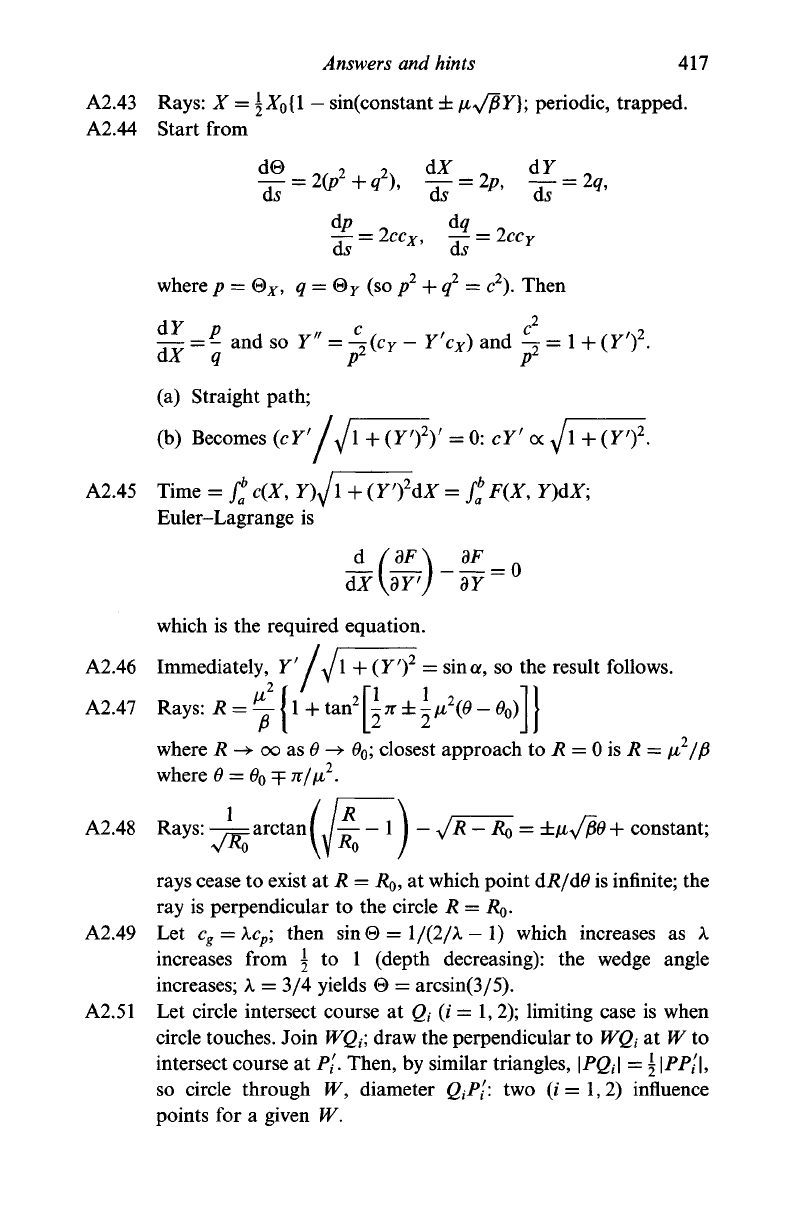
Answers and hints All
A2.43 Rays: X = \X
0
{\
—
sin(constant
db
jx^Y}\
periodic, trapped.
A2.44 Start from
d® „,
2 2x
dX ^ dY „
2
^ +> ^
2
where /? - S
x
, q = S
Y
(so p
1
+ q
1
= c
2
). Then
g=^
and so Y" =y
2
(c
Y
-
Y
f
c
x
)
and ~= 1
(a) Straight path;
(b) Becomes (cY
f
A/l+(7')
2
)' =
0:
c7' a
A2.45 Time = /* c(X, Y)y/l+(Y')
2
dX = f
a
F{X, Y)dX;
Euler-Lagrange is
dxyaFv dY
which is the required equation.
A2.46 Immediately, Y' /
y]
1
+ (Y'f = sin a, so the result follows.
A2.47
Rays:
R
=
fj j
1
+
tan
2
|"I
TT
± \
fi
2
(0
-
0
0
)]
J
where R -> oo as 0 ->• ^
0
J closest approach to i? = 0 is R = /z
where 0 = 0
0
=FTT//X
2
.
1 / fR \
A2.48 Rays: -=rarctan[ /— - 1 I - JR-Ro = ±/xv^6>+ constant;
rays cease to exist at R = R
o
, at which point dR/d6 is infinite; the
ray is perpendicular to the circle R = R$.
A2.49 Let c
g
—
Xc
p
\ then sin0 = l/(2/A.
—
1) which increases as X
increases from \ to 1 (depth decreasing): the wedge angle
increases; k = 3/4 yields 0 = arcsin(3/5).
A2.51 Let circle intersect course at Q
t
(i—l, 2); limiting case is when
circle touches. Join WQ
t
\ draw the perpendicular to WQ
t
at W to
intersect course at P/. Then, by similar triangles, \PQ
t
\ = \ |PP/|,
so circle through W, diameter QiP[\ two (i = l,2) influence
points for a given W.

418 Appendix D
A2.52 Let W be at
(0,b),
then W lies on the circle (a-\Utf + b
2
= ^U
2
t
2
: quadratic in t, given a, b, U.
A2.53 Circular path: circle of radius R, centre at (0, R), ship at origin.
Write P
f
as (X, Y) =
R(sin
a,
1-cosa),
a=Ut/R, then W
is (x,y) = {X -rcos(a +
0),
Y-rsin(a
+
0};
cf. Figure 2.13.
Condition of stationary phase is r = ^Xcos
2
0 (equation 2.122)
which gives
(JC,
y). Often written as
x/R
=
sin(/x
cos 0)
—
-
/x
cos
2
0
cos(0 +
/x
cos 0)
y/R
=
1
— cos(/x
cos 0)
—
-
/x
cos
2
0 sin(0
+
/x
cos 0)
where
/JL
= X/R, a = /xcos0 (equation 2.122). Straight-line
course is R -> oo, /fyx =
A
(fixed).
A2.54 Use Q = -5-v/pF|k|
3
and follow Section 2.4.2; roots for tan0
always real.
A2.55 h = H{t - x/(3Vh -
2c
0
)};
u=U{t- x/(3u/2 +
c
0
)}
(c
0
-
y/ho).
A2.56 u = constant on lines dx/dt = 3w/2
4-
c
0
(c
0
=
y/ho);
consider
characteristic through t = a, x = X(a), then u = X'(ct) on lines
x - (3X
f
(a)/2 + c
o
)(f - a) = X(a); also h = (X
r
(Q:)/2 + c
0
)
2
.
A2.57 / = kZ, with c'J\+H =
=F§,
gives -k = 2k(k - 3yfkJ2\ which
has the solution k—\\ this is the no-shear case.
A2.58 Set
X =
%
+
r)
= 2(u-at), Y =
rj
- £ =
4c,
t = (- \ X + T
Y
/ Y)/a:
(after one integration + decay conditions). Then c = Y/4,
u =
T
Y
IY,
and x = (XT
Y
/ Y + \ (f
Y
/ Y)
2
- \
f
x
)/2a
where
f =T- \XY
2
\ T = AJ
0
(o)Y)cos(o)X), say, since shoreline is at
Y = 0. Maximum run-up is where u = 0; which determines X
and hence x. Far from the shoreline is Y
->
oo.
A2.59 First show that / = 0 can be written as ?
Y
- t
2
x
= 0, then that
t
Y
±t
x
=
Aco
2
{J
2
(coY)cos(coX)
± J
{
(coY)sin(coX)}/Y^\.
So / = 0, provided
Aco
3
> 1, first on Y = 0.
A2.60
M
+
/M" = 2/G/l + 8JF
2
- 1) <
1
for F > 1; form M
+2
//Z
+
=
a/(Vl + a - I)
3
, where a = SF
2
(> 8) where a < (\/l +a - I)
3
(from, for example, 4 + a > 4V1 + a, a > 8). For the bore, move
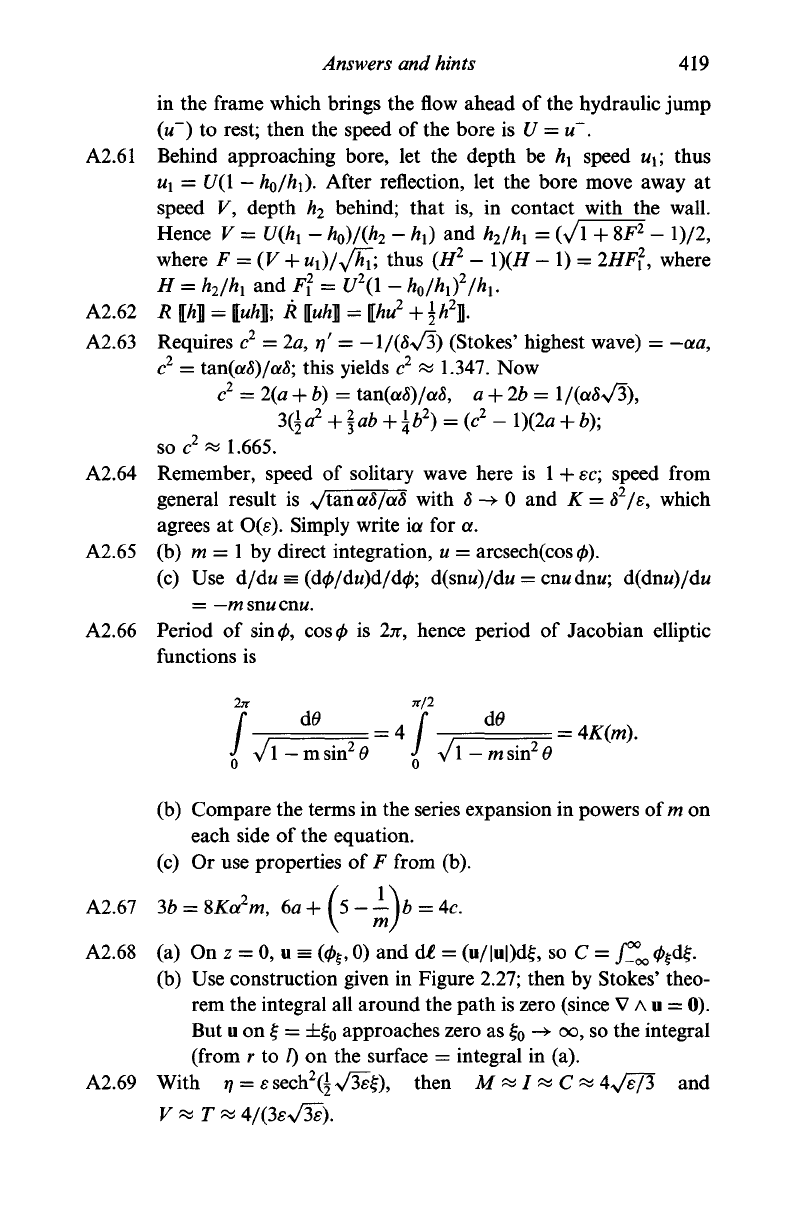
Answers
and
hints
419
in
the
frame which brings
the
flow ahead
of the
hydraulic jump
(M~)
to
rest; then
the
speed
of the
bore
is U = u~.
A2.61 Behind approaching bore,
let the
depth
be h
x
speed
u
x
;
thus
u
x
= U(l -
h
o
/hi). After reflection,
let the
bore move away
at
speed
V,
depth
h
2
behind; that
is, in
contact with
the
wall.
Hence
V = U(h
x
-
h
o
)/(h
2
- h
x
) and
h
2
/h
x
= (\/1 +
8F
2
- l)/2,
where
F = (V +
u
x
)/J7T
x
;
thus
(H
2
- l)(H - 1) =
2HF}
9
where
H
=
h
2
/h
x
and F\ = U
2
(l -
h
o
/h
x
)
2
/h
x
.
A2.62
R
[A]
=
[uA];
R
luhj
= \hu
2
+\ti\
A2.63 Requires
c
2
= 2a,
r)'
=
-1/(8^/3) (Stokes' highest wave)
= -aa,
c
2
=
ten(a8)/a8; this yields
c
2
«
1.347.
Now
c
2
=
2(a
+
b)
=
tan(a«)/a«,
a +
2b
=
l/(a«>/3),
l{\a
2
+
f oft
+ |ft
2
) =
(c
2
-
l)(2a
+
b);
so
c
2
«
1.665.
A2.64 Remember, speed
of
solitary wave here
is
1
+
sc; speed from
general result
is
y/ta,na8/a8 with
5 -• 0 and K = 8
2
/e,
which
agrees
at O(e).
Simply write
ia for a.
A2.65
(b) m
—
\ by
direct integration,
M
=
arcsech(cos 0).
(c)
Use d/dw
==
(d</>/dw)d/d0; d(snw)/dM
=
cnw
dnw;
d(dnw)/dM
= — m snw cnw.
A2.66 Period
of
sin</>, cos0
is
2JT,
hence period
of
Jacobian elliptic
functions
is
In
nil
4
/
Vl-msin
2
^
J
y/l-msm
z
0
(b) Compare the terms
in
the series expansion in powers of m
on
each side
of
the equation.
(c)
Or
use properties
of F
from (b).
A2.67
3b
=
%Ka
2
m,
6a+(s-^)b =
Ac.
A2.68
(a) On z = 0, u =
(0
t
,
0) and d£ =
(u/|u|)d§,
soC =
/_°°
oo
0^d§.
(b)
Use
construction given
in
Figure 2.27; then
by
Stokes' theo-
rem
the
integral
all
around
the
path
is
zero (since V
A
u = 0).
But
u on £ = ±£
0
approaches zero
as
£
0
-*
°°>
so the
integral
(from
r to I) on the
surface
=
integral
in (a).
A2.69 With
r\
=
e sech
2
(i
V3e£),
then
M « / « C «
4V£/3
and
F « 7
1
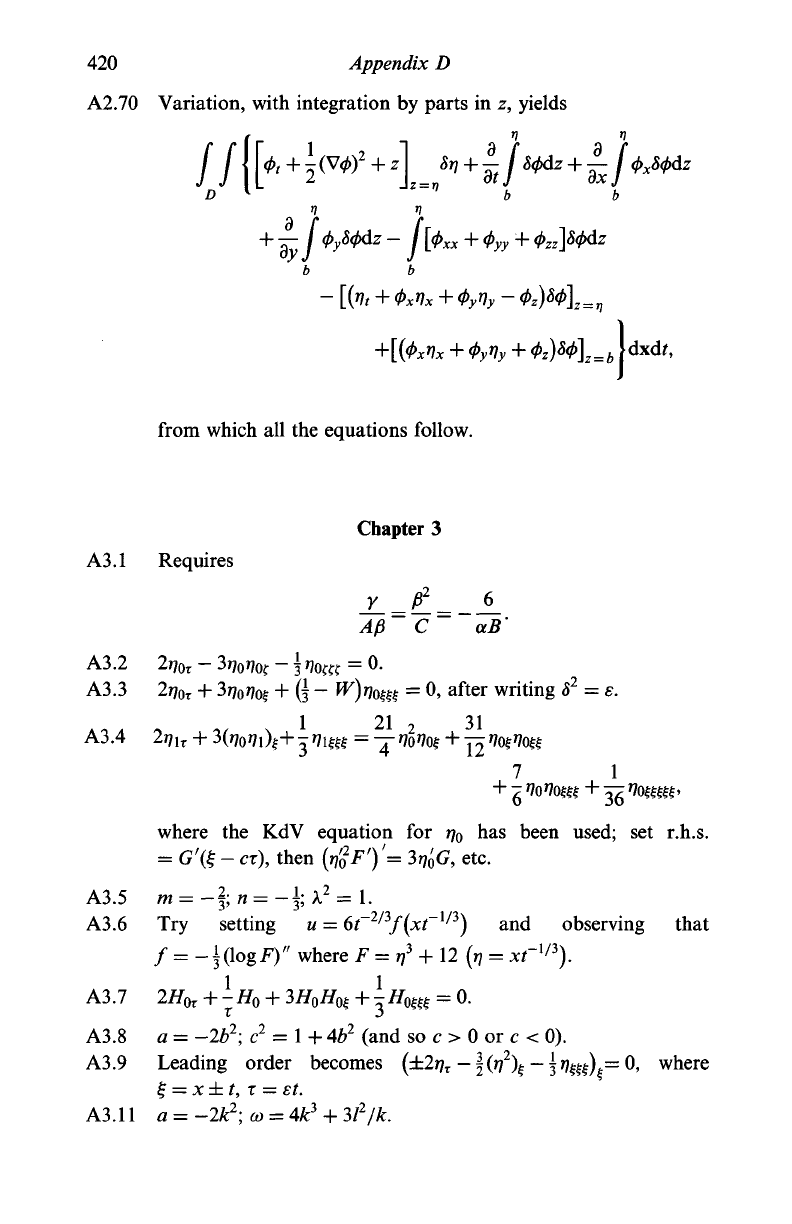
420 Appendix D
A2.70 Variation, with integration by parts in z, yields
//([*,
+
jwr
+z
a
b
]
Sri+
tif
s<pdz+
'L
b
=
rj
z=b
from which all the equations follow.
Chapter 3
A3.1 Requires
A/3
C aB'
A3.2 2TJ
0T
-
3rj
0
rj
0
^
-
±
t]
0
^ = 0.
A3.3 2rj
0r
+
3r]
O
rj
o
^
+ (\ - W)ri
m
= 0, after writing 8
2
= s.
A3.4 2rj
u
+ 3(?7o»7i)|+3
»7if||
= ^^Of + ^^^^
7 1
where the KdV equation for y/
0
has been used; set r.h.s.
= G'fc - cr), then (^Fy= 3^G, etc.
A3.5 m = -f,n = -±;X
2
= 1.
A3.6 Try setting u = 6t~
2/3
f(xt~
x/3
) and observing that
/ = -±(logF)" where F =
rj
3
+ 12
(rj
=
xf
1/3
).
A3.7
2H
0r
+ ±H
0
+
37/
0
//
0
|
+1 ^o^
=
0.
A3.8 a = -2b
2
; c
2
=
1
+
4Z>
2
(and so c> 0 or c < 0).
A3.9 Leading order becomes (±2r;
T
—
|(^
2
)^
—
^^).= 0, where
%
= x±t,r = st.
A3.11 a = -2fc
2
;
£y
= 4k
3
+ 3/
2
/&.
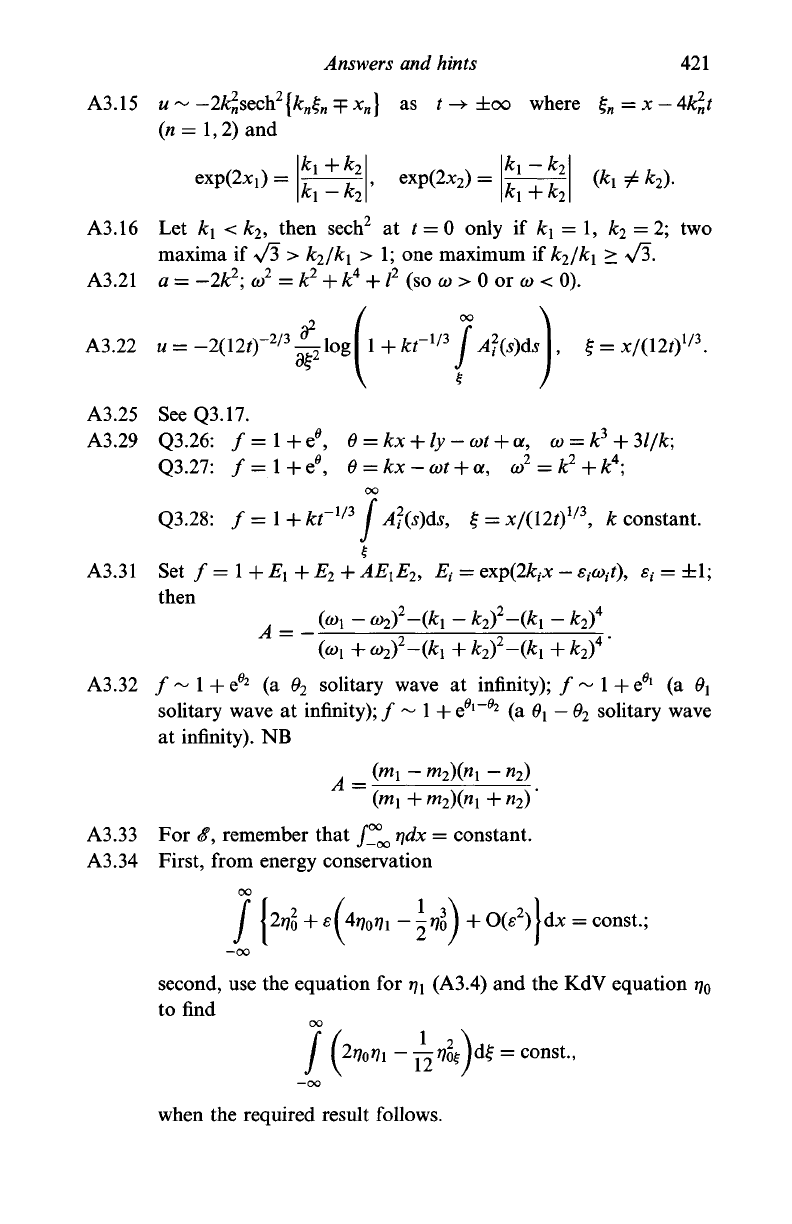
Answers
and
hints
421
A3.15
u ~
— 2k
2
l
sech
2
{k
n
%
n
^ x
n
}
as
t->• ±00
where
%
n
= x
—
4k
2
,t
(n=
1,2) and
exp(2xO
=
k
{
+k
2
, exp(2x
2
)
=
A:,
-A:-
A3.16
Let
A;!
< k
2
,
then sech
2
at t = 0
only
if k
x
= 1, fc
2
= 2; two
maxima
if
-s/3
> k
2
/k\ > 1; one
maximum
if k
2
/k
x
>
-s/3.
A3.21
a = -2k
2
; a? = k
2
+ k
4
+1
2
(so
a>
> 0 or
co
< 0).
A3.22
u =
-2(120
"
2/3
^
A3.25
See
Q3.17.
A3.29 Q3.26: / =
1
+ e
e
, 0 = kx + ly-oot + u,
(0
= ^ + 3l/k;
Q3.27:
f=l+e
0
, 0 = kx-a>t +
<x,
co
2
= k
2
+k
4
;
OO
Q3.28:
/ =
1
+ kt~
l/3
f
AJ(s)ds,
§ = x/(l2t)
l/
\ k constant.
A3.31
Set / =
1
+ E
x
+ E
2
+
^£i£
2
>
£,- =
exp(2fc,oc
-
e^-O,
^ =
±1;
then
A
=
(°>i
~
coif-jk,
- k
2
f-(k
x
- k
2
f
A3.32
/ -
1
+
Q°
2
(a 6
2
solitary wave
at
infinity);
/ ~
1
+
e*
1
(a 6
X
solitary wave
at
infinity);
/ ~
1
+
e
6
*
1
"
02
(a
Q
x
—
0
2
solitary wave
at infinity).
NB
A
=
(m
x
+
m
2
)(n
x
+ n
2
)'
A3.33
For $,
remember that
/^ ^dx =
constant.
A3.34 First, from energy conservation
OO
j\
L ^
+ O(e
2
)|dx = const.;
OO
J
j2f]\
+
eLiji
-
^o J + O(e
2
)|dx
=
second,
use the
equation
for
rj
x
(A3.4)
and the KdV
equation
rj
Q
to find
OO
/ ^2*70*71
- j2 ^W =
const
"
—
OO
when
the
required result follows.

422 Appendix D
A3.36 Form
(xu + 3tu\ = (Utu
2
- 6tuu
xx
+ 3tu\ + 3xu
2
- xu
xx
+ u
x
)
x
.
A3.37 Use Q3.36; the centre of mass has the x-coordinate
(f™
oo
xudx)/(f™
oo
udx). Consider two solitons (u\,u
2
) far apart,
and then write u
—
u
x
+ u
2
.
A3.38 Write
N
U
~ —
k
n(x ~ 4k
2
n
t - x
n
)} as / -• +00,
then
f udx =
-2f2K;
t
J
« =
1
J
etc.
A3.40 For the third law, add Hx (first equation) to U x (second
equation).
A3.44 c = ±1: h* =
TI;
7
41
= 1; J
x
=\.
c = -
A3.45
7
41
=-
x
U
o
^1) + 3c
2
etc.
A3.46 (a) With critical level, c given in A3.45 is recovered for which
c >
Ux
or c <
U
o
:
no critical level,
(b) With critical level, then a = c/U satisfies (for a < 1)
1-
= ln
= 2t/?a(a - 1),
which has one solution only, namely in a < 0: no critical
level.
A3.47
c(c
- Ui)
2
= c -
dU
x
:
three real roots (for 0 < d < 1) with one
satisfying 0 < c < U\\ critical level exists.
A3.48 a = c/U
x
satisfies (cf. A3.46)
1 -
a
= ln
1 -y/T^
2
d
2a(l - d)

Answers and hints
423
and
one
solution satisfies 0<a<l: critical level exists.
NB Interesting exercise: examine this equation
for d -»
1;
d
->•
0.
A3.49
See
equation (3.139).
A3.50 l+ccos0
o
= U
o
±l.
A3.51 Choose
c=U\\ k =
a
cos
0
+
ft(tf)
sin 0
where
ft
2
=
1
+
a(U
x
-
U
o
)
- a
2
.
A3.52
Set
h(p)
=
a(p)
cos/?
+
b(p)
sin/7
and
h'(p)
=
—a(p)
sin/7
+
b(p)
cos/7,
then dh/dp
=
/*'(/?) requires
a
f
cosp
+
Z/sin/7
= 0 (and a, b are
related
by
equation (3.139b)). Required solution
is
described
by
the
set: a =
—
Z/tan/7,
h =
a
cos/7
+
6
sin/7,
equation (3.139),
/?
derivative
of
equation (3.139).
A3.53
D = (aX +
6)
9/4
,
0, ft
constants.
A3.54 Takes
the
form (H$)
x
-±l?
/4
(H$s)
x
+Qs
= 0, for
some
g.
A3.56
(2F
t
+ |/f + \F
m
)= O(s) and 7/ -
F
H
.
Chapter
4
A4.1
^(f,
r)
-
/^/(
z
A4.2
(a) F = A
cosh(coz)
+
J9
sinh(wz)
+
-—
sinh(coz);
(b)
F = A
cosh(a;z)
+ B
sinh(wz)
H
=•
\coz
2
cosh(coz)
—
z
sinh(coz)}.
A4.4
u =
(p
x
=
(f>£
+
£0£
= e/o^+
periodic terms.
A4.5
See
equations (4.43).
A4.6
For 8^0:
-2ik8
2
A
0z
+
SWAQK
-
8
2
A
0YY
+1AO\AO\
2
+ 38
2
k
2
A
0
f
0
^ = 0,
for 6
-> 00:
with
c^ ~
l/VSk
then
